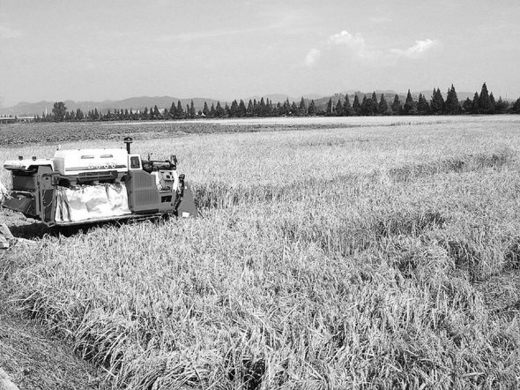 |
|
Last year's first harvest of Gyeonggi province's rice farm in Yongsung, Pyongyang.
|
Civic groups have picked up where Seoul left off
The fields of North Korea are teeming with people planting this year’s rice seedlings. The Rodong Sinmun, the North’s newspaper, urged in its May 15 edition that all North Korean people focus their efforts on rice planting. Even embassy workers of Indonesia, Vietnam, and Mongolia in the North are providing support for rice farming activities there, according to sources. Expanded inter-Korean cooperation in farmingSouth Korean civic groups also chipped in to help with the North’s rice planting. For example, the Korean Foundation for World Aid planted rice seedlings on a 2.4 million pyeong (7.9 million square meter) rice paddy in Gangwon province in mid-April, earlier than usual, in order to provide more productive rice seedlings for the North. On May 15, seedling transplantation by South Korean farmers began in the paddies surrounding Pyongyang. Government officials from the two Koreas held a meeting in the Kaesong special joint economic zone August 18-19 last year, where they signed a seven-point agreement on improving bilateral ties and cooperation in the agricultural sector. Under the agreement, the two Koreas promised to establish a cooperative channel at a vice-ministerial level and pursue building cooperative farms. Both countries came to an agreement to expand their cooperation into all sectors of farming, including personnel and raw materials. You Sun-ho, a lawmaker of the ruling Uri Party, called it a "new turning point" in inter-Korean relations in the agricultural sector. However, since the agreement, the negotiations have been at a stalemate, the date for further discussion yet to be set. But the void in the government-led effort is being filled by civic groups seeking close cooperation with the North in the farming sector. Better rice farming environment in the North So far, South Korea has focused on providing fertilizer and rice to the North as part of its humanitarian aid to the poverty-stricken country. But unlike such a one-off event, the efforts led by civic groups and local governments are centering on jointly developing farming techniques and running cooperative farms in a way to provide sustainable help for the North. The effort made by Gyeonggi province is a prime example of such success stories. The province opened a rice farm near Pyongyang last year, and by employing state-of-the-art farming techniques Gyeonggi said it was able to produce 494 kilograms of rice per 300 pyeong of land, twice the production efficiency of other North Korean farms. Among the 14.8 tons of rice harvested from the cooperative farm, Gyeonggi province shipped 1 ton to the South and distributed the rest in the North. Modernization of the North’s agriculture sector Based on its achievements, Gyeonggi province is stepping up efforts to seek closer cooperation with the North. The province expanded the size of its cooperative farm in Pyongyang and agreed with its North Korean counterpart to jointly build up farming infrastructure and improve the standard of living of farm households in the area. The province aims to provide sustainable means for the North, even if no outside aid were to reach the country. "The cooperation is is intended to modernize the North’s agricultural sector," said a Gyeonggi province official in charge of the cooperation project. Experts see these new cooperative approaches on the side of the North as being in line with a law enacted last July. Under the law, the North proposed seeking new "complementary cooperation" by sharing the South’s know-how in the light industry and natural resources fields.





